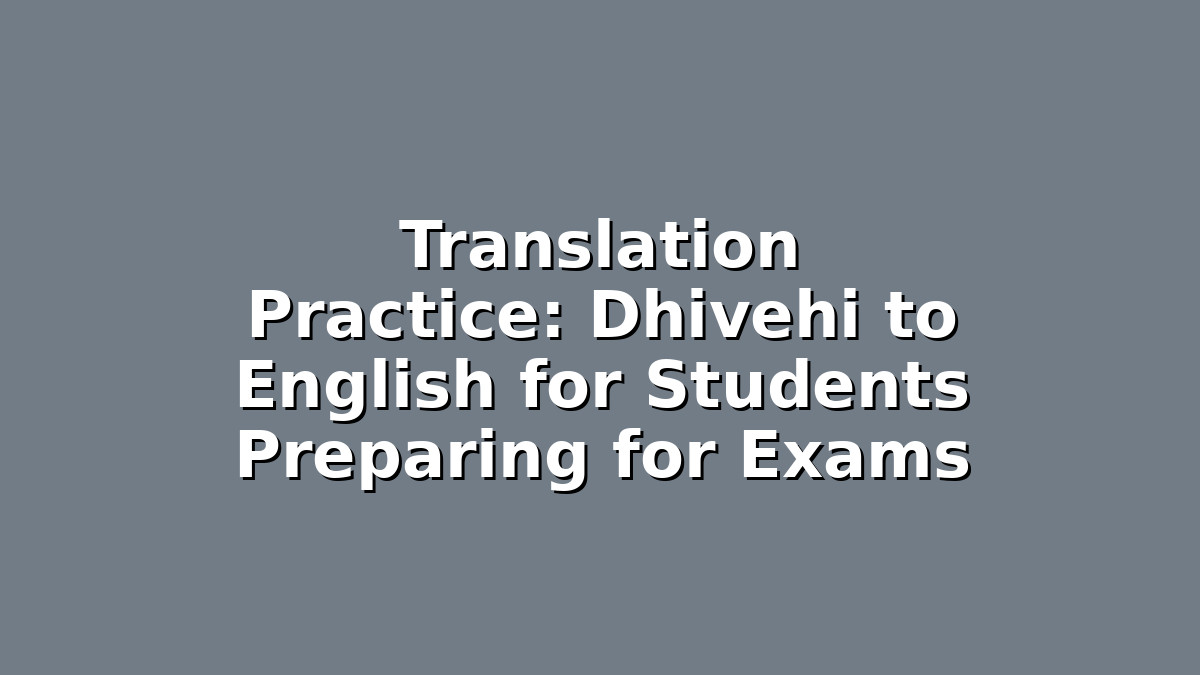Preparing for exams can be a challenging yet rewarding experience, especially when it comes to mastering languages. For students studying Dhivehi and English, translation practice is an essential skill that not only helps improve linguistic abilities but also boosts overall confidence in both languages. Whether you are preparing for school exams or language proficiency tests, translating from Dhivehi to English can enhance your vocabulary, grammar understanding, and cultural insights. In this article, we will explore effective study tips and methods to help you excel in translation practice from Dhivehi to English.
Understanding the Importance of Translation Practice
Translation is more than just converting words from one language to another; it’s about conveying meaning accurately and naturally. When you translate Dhivehi into English, you’re bridging two different linguistic systems and cultural contexts. This process helps deepen your comprehension of grammar structures, idiomatic expressions, and contextual usage in both languages.
For students preparing for exams, translation practice is particularly important because it tests a variety of skills simultaneously. It improves reading comprehension in Dhivehi, writing proficiency in English, and critical thinking as you decide on the best way to express ideas. Consistent practice will make you more comfortable with both languages and sharpen your analytical skills, which are crucial for exam success.
Section 1: Build a Strong Foundation with Vocabulary and Grammar
Before diving into extensive translation exercises, it’s essential to have a solid grasp of vocabulary and grammar in both Dhivehi and English.
Expand Your Vocabulary:
Vocabulary is the core of any translation. Start by compiling lists of common words and phrases used in daily conversation, academic texts, and exam-related materials. Use flashcards, apps, or vocabulary notebooks to reinforce your learning. To make this process more effective, focus on thematic vocabulary—for example, words related to education, environment, culture, or technology—since exam passages often revolve around such topics.
Master Grammar Rules:
Both Dhivehi and English have unique grammar structures. Understanding sentence formation, verb tenses, subject-verb agreement, and the use of prepositions is crucial. Practice grammar exercises regularly, focusing especially on areas where the two languages differ. For example, English relies heavily on auxiliary verbs, while Dhivehi may express tense differently. Recognizing these differences will help you avoid common errors during translation.
Use Bilingual Dictionaries Wisely:
While bilingual dictionaries are valuable tools, don’t rely on them exclusively. Use them to confirm meanings and explore synonyms, but always cross-check how words are used in context by reading sample sentences or literary texts. This approach will prevent literal translations that don’t convey the intended meaning.
Section 2: Practice Translation Techniques and Strategies
Effective translation is not just about word-for-word conversion but about transferring meaning, tone, and style.
Understand the Context:
Before translating a passage, read it thoroughly to grasp its overall meaning and purpose. Ask yourself what the text is about, who the intended audience is, and what tone it uses—formal, informal, descriptive, or persuasive. This understanding will guide your choice of vocabulary and sentence structures in English.
Start with Simple Sentences:
Begin your practice with simple sentences and gradually move to more complex paragraphs. This approach allows you to focus on accuracy without getting overwhelmed. For example, translate short dialogues or daily conversations before attempting longer literary texts or academic excerpts.
Paraphrasing and Summarizing:
Sometimes, direct translation can be awkward or confusing. Learn to paraphrase—expressing the same idea in a different way—to make your English translations sound natural. Summarizing key points instead of translating every single word can also be useful when dealing with long texts.
Compare Your Work:
After translating, compare your version with official translations or sample answers if available. Identify areas where your translation could be clearer, more concise, or more accurate. Seeking feedback from teachers, peers, or language tutors can be very helpful to improve your skills.
Section 3: Incorporate Regular Translation Practice into Your Study Routine
Consistency is key in mastering translation from Dhivehi to English. Here are some practical tips to integrate translation practice into your daily study schedule.
Set Realistic Goals:
Start by dedicating 15 to 30 minutes a day to translation practice. Set specific goals such as translating a paragraph, five sentences, or a news article. Gradually increase the complexity and length of your practice texts as your skills improve.
Use Diverse Resources:
Explore various sources for translation practice materials, including Dhivehi newspapers, short stories, government publications, and educational content. This diversity exposes you to different writing styles and vocabulary.
Create a Study Group:
Forming a small study group with classmates can provide motivation and varied perspectives. You can exchange translation exercises, discuss challenging phrases, and learn from each other’s mistakes and successes.
Keep a Translation Journal:
Maintain a dedicated notebook or digital document where you record your translations along with notes on difficult words or grammar points. Revisiting this journal regularly helps reinforce learning and track your progress over time.
Leverage Technology:
Use language learning apps, online forums, and websites that offer translation exercises or allow you to practice Dhivehi and English. Some platforms provide instant corrections and explanations, which can accelerate your learning process.
Conclusion
Translation practice from Dhivehi to English is a powerful tool for students preparing for exams. By building a strong foundation in vocabulary and grammar, applying effective translation strategies, and maintaining consistent practice, you can significantly improve your language skills. Remember, translation is not just about transferring words but about expressing meaning clearly and naturally. Stay patient and persistent, and don’t hesitate to seek help when needed. With dedication and the right techniques, you can master translation and excel in your exams confidently.
Keep practicing, stay motivated, and enjoy the journey of becoming bilingual!

Responses